Nanometer Tungsten Trioxide Photocatalyst Paper-Based Bamboo Curtain
- Details
- Category: Tungsten Information
- Published on Wednesday, 25 May 2016 18:04
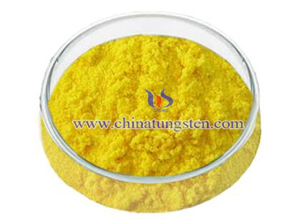 As the changing of live and work patterns, the time neoteric stay in the indoor environment is increasingly extended, almost more than 90% of the time spent indoors. New building materials especially synthetic building materials are widely used in modern building, and the indoor air quality is seriously declined. Photocatalyst is the general optical semiconductor material which represented by nanoscale titanium dioxide with a photocatalytic function, and being one of the safest material on the international governance of indoor environmental pollution. Mechanism of photocatalyst is that dielectric material generates electron-positron charges under light, and decomposes the water in the air into hydrogen ions, thus results in decomposition reduction.
As the changing of live and work patterns, the time neoteric stay in the indoor environment is increasingly extended, almost more than 90% of the time spent indoors. New building materials especially synthetic building materials are widely used in modern building, and the indoor air quality is seriously declined. Photocatalyst is the general optical semiconductor material which represented by nanoscale titanium dioxide with a photocatalytic function, and being one of the safest material on the international governance of indoor environmental pollution. Mechanism of photocatalyst is that dielectric material generates electron-positron charges under light, and decomposes the water in the air into hydrogen ions, thus results in decomposition reduction.| Tungsten Oxide Supplier: Chinatungsten Online www.tungsten-oxide.com | Tel.: 86 592 5129696; Fax: 86 592 5129797;Email:sales@chinatungsten.com |
| Tungsten News & Prices, 3G Version: http://3g.chinatungsten.com | Molybdenum News & Molybdenum Price: http://news.molybdenum.com.cn |
Tungsten Alloy Nuclear Radiation Shielding
- Details
- Category: Tungsten Information
- Published on Wednesday, 25 May 2016 18:03
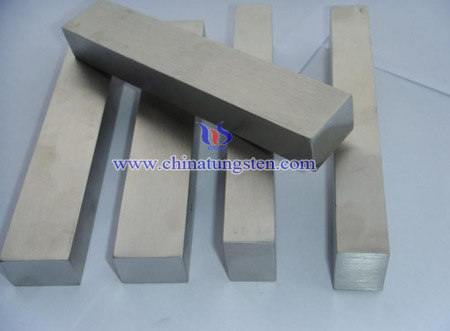 Nuclear radiation, also known as ionizing radiation, is the microscopic particle flow released from the transition process of atomic nucleus (from an energy state of a structure or a structure into another energy state or another structure) that can cause the ionization or excitation in materials. Nuclear radiation is mainly produced by nuclear reactions, or released from fission products. Nuclear explosions and nuclear accidents will also generate nuclear radiation, including α, β and γ three kinds of rays. Nuclear radiation can cause harm to human body, while the sensitivity of the somatic and germ cells of the body to nuclear radiation and the damage effects of them are different. Once somatic cells are damaged, can lead to diseases in the organ tissues and ultimately death, and the damaged cells will not be transferred to the next generation after the death of the body cells; while once reproductive cells are damaged, the next generation will inherit the parent‘s changed gene, so that leads to defects in the offspring.
Nuclear radiation, also known as ionizing radiation, is the microscopic particle flow released from the transition process of atomic nucleus (from an energy state of a structure or a structure into another energy state or another structure) that can cause the ionization or excitation in materials. Nuclear radiation is mainly produced by nuclear reactions, or released from fission products. Nuclear explosions and nuclear accidents will also generate nuclear radiation, including α, β and γ three kinds of rays. Nuclear radiation can cause harm to human body, while the sensitivity of the somatic and germ cells of the body to nuclear radiation and the damage effects of them are different. Once somatic cells are damaged, can lead to diseases in the organ tissues and ultimately death, and the damaged cells will not be transferred to the next generation after the death of the body cells; while once reproductive cells are damaged, the next generation will inherit the parent‘s changed gene, so that leads to defects in the offspring.
Radioactive substances of the nuclear radiation include iodine 131 and cesium 137, which can enter the body through breathing, skin wounds and gastrointestinal absorption, causing internal radiation. Once iodine 131 enters the human body, it can cause thyroid disease; while Cs-137 will damage the body's blood system and the nervous system after it entering the human body, therefore nuclear radiation must be avoided by humans. γ radiation can also penetrate a certain distance to be absorbed by the body, and cause radiation damage. Symptoms of radiation sickness caused by internal and external radiation include hair loss, leukemia, bleeding, vomiting, fatigue, skin redness, dizziness, insomnia, ulcers, diarrhea. Sometimes internal and external radiation will increase the incidence of distortion, cancer, hereditary disease, and affect the health of future generations. In general, the more radiation energy received by the body, the more serious their symptoms of radiation sickness, and the greater the risk of carcinogenic, teratogenic.
Tungsten alloy nuclear radiation shielding is a tungsten alloy shielding with excellent radiation shielding performance, high temperature resistance and strong applicability. Lead is used as a shielding material early, but its shielding effect is not as good as the tungsten alloy shielding. Tungsten alloy shielding is the best choice. Due to the high density of tungsten alloy shielding, its shielding effect is twice that of lead. In addition, lead and its compounds are toxic and dangerous to human health,while tungsten alloy shielding is harmless non-toxic, will not cause harm to human health.
| Tungsten Alloy Supplier: Chinatungsten Online www.tungsten-alloy.com | Tel.: 86 592 5129696; Fax: 86 592 5129797;Email:sales@chinatungsten.com |
| Tungsten News & Prices, 3G Version: http://3g.chinatungsten.com | Molybdenum News & Molybdenum Price: http://news.molybdenum.com.cn |
Nano Tungsten Carbide Processes
- Details
- Category: Tungsten Information
- Published on Wednesday, 25 May 2016 17:03
There are some common used nano tungsten carbide powder processes as follow:
1. MA (Metal Alloying): It is a by high energy ball milling the powder is subjected to repeated deformation, cold welding, broken, so as to achieve inter-atomic level alloying element complex physical and chemical process. It has simple operation, high efficiency and the granularity of grains can meet the requirements, but the powder pollution often caused by the friction between tank and balls;
2. SCP (Spraying Conversion Process): It is a new kind of process by American scholars. It uses ammonium paratungstate (CH4) 6 (H2W12040) and an aqueous solution of cobalt chloride CoCl2 • nH2O or Co (en) 3WO4 and H2WO4 tungstate solution by spray drying and fluidized-bed reduction and carbonization reaction homogeneous grain powder (20-50nm);
3. In-situ carburization: It combines in-situ synthesis and carburizing process. In situ synthesis is the use of different elements or compounds react under certain conditions, and in the metal matrix to generate one or more ceramic phase particles have reached the improvement of a single metal alloy. American scholars used polyacrylonitrile as carbon source in situ, without vapor carbide, tungsten and cobalt salts are dissolved in acid polyacrylonitrile solution, low-temperature drying after move 90% Ar-10% argon, hydrogen H2 reduction of direct reduction furnace was cemented carbide powder, the grain size of about 50-80nm;
4. Co-precipitation: Mix different chemical composition and add in solution in a mixture of appropriate preparation precipitating agent precursor precipitate and then the precipitate is dried or calcined, to thereby obtain the corresponding powder particles, which is an important method for preparing a composite oxide containing two or more kinds of ultra-fine powders of metal elements. The researchers use the sodium tungstate or tungsten and cobalt ammonium acetate co-precipitation WC-Co precursor powder through hydrogen reduction and carbonization reaction made cemented carbide powder (about 50nm). However, this method is only applicable to the W / Co atomic ratio close to 5.5. While the use of ammonium tungstate and cobalt hydroxide precipitate will be able to co-atomic ratio of the high-side W / Co, access to a broader range of composite powder.
In addition, there are some other synthesis methods, such as vapor evaporation, high-frequency plasma synthesis, high-frequency induction heating synthesis, ARC. But they all still in the research step, which did not put into practical production. Nano carbide fine and uniform microstructure, mechanical properties have been significantly enhanced. The mean free path of cobalt binder phase is shortened, crack propagation resistance will be improved, the better the toughness of cemented carbide. As tungsten carbide micro drills, nano tungsten carbide micro drill has higher efficiency, lower wear consumption, longer service life.
| Tungsten Carbide Supplier: Chinatungsten Online tungsten-carbide.com.cn | Tel.: 86 592 5129696; Fax: 86 592 5129797;Email:sales@chinatungsten.com |
| Tungsten News&Tungsten Prices, 3G Version: http://3g.chinatungsten.com | Molybdenum News & Molybdenum Price: http://news.molybdenum.com.cn |
Nano Tungsten Carbide Developments
- Details
- Category: Tungsten Information
- Published on Wednesday, 25 May 2016 17:02
Generally, tungsten carbide is a kind of super-hard composite material consists of refractory metal carbide (e.g., WC, TiC), and the binder by transition metals or alloys (such as Fe, Co, Ni). It has high hardness, high strength, high melting point, excellent thermal hardness and wear resistance and corrosion resistance and other advantages. In the early 1920s, germen first adapted PM (Powder Metallurgy) to fabricate WC tungsten carbide, which put forward tungsten carbide widely used in aerospace, machinery processing, metallurgy, oil drilling, mining tools, electronic communications, construction, military and other fields.
Originally, tungsten carbide mainly used in drawing die and some wear parts manufacturing. And due to the technologies, process and performance improvements, it gradually plays an important role in metal cutting industries. With the further study, the researchers found that the smaller size of WC in granularity, the shorter mean free path of the binder Co, which has a dramatical increase in the hardness and strength of the alloys. Especially when the WC grain size reduces to about 100 nm, there will be a obvious breakthrough in the mechanical properties.
Today, in some emerging industries as well as some areas of difficult to machine materials fields, such as air super-alloy materials processing, electronics industry, using a wide range of printed circuit board (PCB) drilling, composite sheet metal processing, glass-fiber reinforced structural thermoplastic material, dot matrix printer head, the precision cutting of glass, etc., all need to be completed by nano tungsten carbide cutting tools with higher hardness and better strength. However, in the process of tungsten carbide densification, the growth of grains is an inevitable phenomenon. So in order to obtain nano tungsten carbide, we should synthesize finer powder in advance.

| Tungsten Carbide Supplier: Chinatungsten Online tungsten-carbide.com.cn | Tel.: 86 592 5129696; Fax: 86 592 5129797;Email:sales@chinatungsten.com |
| Tungsten News&Tungsten Prices, 3G Version: http://3g.chinatungsten.com | Molybdenum News & Molybdenum Price: http://news.molybdenum.com.cn |
Comparison of Tungsten Round Bar and Tungsten Square Bar
- Details
- Category: Tungsten Information
- Published on Wednesday, 25 May 2016 11:28

Uneven tungsten billet sizes would cause the nonuniform resistance and large different temperature of each part of wolfram bar during a sintering process. Therefore, due to the different degree of sintering, the degree of combustion of the large size part is too low, but the small part is over-firing, which will cause the fuse. It is best to use the automatic charging machine and tracking piamater retractor and reasonable pressing parameter. So that it can ensure that diameter fluctuations of each part of the round billet can be stabilized within ±0.4mm after sintering.
At the beginning of it, we can see the difference between the square billet and round billet. On the universal testing machine, respectively compare to the compression strength and bending strength of green molding, pre-sintered compact, and isopressed compact. Pressed at the same pressure, the density of isostatic green compact is 1.15 times that of the green molded billet, and compression strength is 6.5 times, its bending strength is 2.7 times that of green die blanks. After pre-sintering, the density of square billet and round billet are approximately the same, compressive strength of round billet is 1.4 times that of square billet, and the flexural strength is 2.1 times. We can finger it out from here that round billet is not easy to be damaged during transport.
When swaging for both materials, it will be found that the surface of the tungsten square bar will often appear subtle cracks, if the swaging temperature rises, then the crack phenomenon would become more serious. Under the same conditions, the round tungsten bar doesn’t have this problem. This is because when the square tungsten is swaging, its edges, faces, and the center pat cannot receive strength evenly, and the degree of deformation also have a greater difference. The tungsten bar is the refined form of tungsten ore, which acts like silver grade tools. But armor and tools made of it will be classed as tungsten equipment. With the processing of tungsten elongated, and the part which did not receive would easy crack with the rest part. Uniform density, round face of cross-section and not forming agent of tungsten round bar eliminate defects of worked structure in a certain extent.
| Tungsten Metals Supplier: Chinatungsten Online www.tungsten.com.cn | Tel.: 86 592 5129696; Fax: 86 592 5129797;Email:sales@chinatungsten.com |
| Tungsten News & Prices, 3G Version: http://3g.chinatungsten.com | Molybdenum News & Molybdenum Price: http://news.molybdenum.com.cn |
Tungsten Bar and Tungsten Rod
- Details
- Category: Tungsten Information
- Published on Wednesday, 25 May 2016 11:25
 Wolfram has the highest melting point of all metals and is therefore also suitable for very high-temperature applications. It is also characterized by a uniquely low coefficient of thermal expansion and a very high level of dimensional stability. Tungsten rod is a kind of metal rod made of metal tungsten, at high temperatures, as a high melting point and low coefficient of thermal expansion material, so it is now widely used for support line, lead-in wire, printer pin, various electrodes and quartz furnace, filament, high-speed tools, automotive products and other industrial fields. Better wear resistance, higher toughness, better deformation and fracture resistance, results in a long life and good size accuracy. Except formed by metal tungsten powder, wolfram rod can also made through the process of the manufacturing of tungsten bar.
Wolfram has the highest melting point of all metals and is therefore also suitable for very high-temperature applications. It is also characterized by a uniquely low coefficient of thermal expansion and a very high level of dimensional stability. Tungsten rod is a kind of metal rod made of metal tungsten, at high temperatures, as a high melting point and low coefficient of thermal expansion material, so it is now widely used for support line, lead-in wire, printer pin, various electrodes and quartz furnace, filament, high-speed tools, automotive products and other industrial fields. Better wear resistance, higher toughness, better deformation and fracture resistance, results in a long life and good size accuracy. Except formed by metal tungsten powder, wolfram rod can also made through the process of the manufacturing of tungsten bar.
Tungsten bar can be divided into wolfram round bars and square bars, during the processing of swaging for tungsten rod, the obtained finished products would have some differences. When both of them are processing to 8mm in diameter, from the view of the sectional of metallurgical structure, the four corners of tungsten square bar are easy to form recrystallized structure under the conditions of processing temperature. If the follow-up process shall not be treated properly, it will result in the interior tissue of the wolfram rod is uneven, which is the main reason for defects and breaking of the following finished wolfram products. On contrary, after tungsten round bar is being stretched to 8mm in diameter, it still remains uniform tissue density. Nonuniform structure tends to cause internal defects of silk material, if uneven degree is very serious that it cannot be processed any more.
Observe hole distribution of this kind of metal rod after annealing, which can be used the scanning electron microscope, you will see the hole of the recrystallized structure correspond to four edges are less, almost no orifice tube, but there are more holes in intermediate position of the wolfram rod. However, there are not exist recrystallized structure of the tungsten round bars, so its tissue distribution remains homogeneous state in follow-up processing. Internal tissue density distribution of tungsten bar has a great impact on the preparation of the following processes of tungsten rod and tungsten products. Therefore, the users should choose the right tungsten bars according to their own requirements.
| Tungsten Metals Supplier: Chinatungsten Online www.tungsten.com.cn | Tel.: 86 592 5129696; Fax: 86 592 5129797;Email:sales@chinatungsten.com |
| Tungsten News & Prices, 3G Version: http://3g.chinatungsten.com | Molybdenum News & Molybdenum Price: http://news.molybdenum.com.cn |
Lithium Tungsten Bronze Photocatalyst Preparation
- Details
- Category: Tungsten Information
- Published on Tuesday, 24 May 2016 18:32
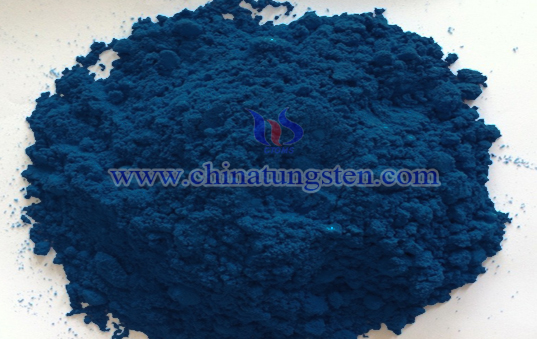
| Tungsten Oxide Supplier: Chinatungsten Online www.tungsten-oxide.com | Tel.: 86 592 5129696; Fax: 86 592 5129797;Email:sales@chinatungsten.com |
| Tungsten News & Prices, 3G Version: http://3g.chinatungsten.com | Molybdenum News & Molybdenum Price: http://news.molybdenum.com.cn |
Rare Earth Affected Rare Earth Tungsten Electrode Reduction Process
- Details
- Category: Tungsten Information
- Published on Tuesday, 24 May 2016 17:47

Rare earth tungsten electrode usually uses powder metallurgy to produce. Using this method for rare earth tungsten electrode manufacturing, the powder quality will directly affect the sintering and processing properties of the electrodes. During mixed powder reduction process, the phase will usually go through WO2.9, WO2.72, WO2, W and β-W phase change. β-W in the actual production is difficult to obtain, but in the mixed rare earth tungsten powder reduction process can often find this material. After the first reduction observed XRD pattern can find β-W diffraction peaks. With the rare earth content increases, the peak intensity increases. In the second reduction, there are also appeared in the same law, indicating rare earth is favor to produce β-W. On the other hand, the presence of β-W powder causes second-step reduction reaction is not complete, and therefore during rare-earth doped, the reduction temperature should higher than pure tungsten. It can be seen, doped with rare earth will change tungsten powder reduction way. During tungsten powder reduction will first to form β-W, and then converted into α-W. β-W is the A15-type structure, which has a superconducting nature, it attracted widespread attention. But for the good performance tungsten electrode production to produce stable α-W is the ultimate goal of reduction. And to improve the reduction temperature can obtain α-W which is complete reduction.
Doped with different rare earth components, under the same conditions, the reduction particle size obtained is not the same. Under the same reduction conditions, the rare earth tungsten powder particle size is significantly smaller than pure tungsten powder, because rare earth can help to refine tungsten oxide grain size. In various rare earth oxides, Y2O3 has better refinement effect and for tungsten powder particle size refinement is the most obvious. In addition, produce multi rare earth tungsten electrode the higher Y2O3 content, tungsten powder refinement is better.
| Tungsten Metals Supplier: Chinatungsten Online www.tungsten.com.cn | Tel.: 86 592 5129696; Fax: 86 592 5129797;Email:sales@chinatungsten.com |
| Tungsten News & Prices, 3G Version: http://3g.chinatungsten.com | Molybdenum News & Molybdenum Price: http://news.molybdenum.com.cn |
Rare Earth Existence Form in Rare Earth Tungsten Electrode
- Details
- Category: Tungsten Information
- Published on Tuesday, 24 May 2016 17:44
In rare earth tungsten electrode, rare earth mainly added in the form of rare earth nitrate. After subsequent doping, drying, reduction processes, rare earth nitrate has be a series of changes and decomposition reactions. Take lanthanum nitrate (La (NO3) 3` • 6H2O) as example, under inert gas to (La (NO3) 3` • 6H2O) will produce H2O, HNO3, NO, NO2, and N2O5 and other gases. The reaction process and decomposition of cerium nitrate and yttrium nitrate is similar with lanthanum nitrate, but the reaction temperature is different.
To dry the doped powders, the drying temperature can reach 150 ℃. Then the rare earth nitrate will lose crystal water. During reduction, the reduction temperature is generally 400 ~ 1000 ℃. At such a high temperature rare earth nitrate is completely decomposed to produce rare earth oxides.
Analyze XRD of reduction powder found after first reduction there are not diffraction peak of rare earth and clear diffraction peak is WO2, β-W (W3O). Indicating that first reduction temperature is lower and the crystal phase of rare-earth is in the low level. Observing the rare earth tungsten powder after second reduction found the diffraction peak mainly α-W, a small amount of β-W, while there has been a significant unknown diffraction peaks. To press and sinter the powder, and then observe its XRD found that the unknown diffraction peak does not disappear. Analyze by PDF card found the peak is similar to rare earth tungstate strongest peak, so it is indicated that the peaks can be rare earth tungstates (La2WO6, Ce2WO6, Y2WO6 and so on.).
Therefore, in the rare earth tungsten electrode, rare earth existence form mainly is LaWO3, Ce2WO6, Y2WO6 and other tungstate. Rare earth tungstate after sintered, its calibration peak and relative intensity did not changed significantly, indicating after reduction and sintering the rare earth existence form has not changed.
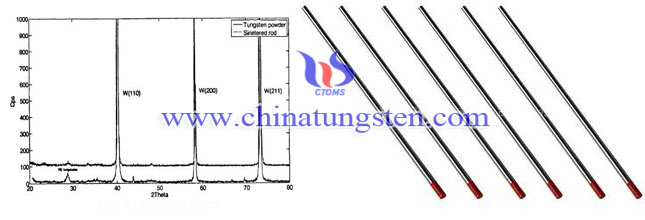
| Tungsten Metals Supplier: Chinatungsten Online www.tungsten.com.cn | Tel.: 86 592 5129696; Fax: 86 592 5129797;Email:sales@chinatungsten.com |
| Tungsten News & Prices, 3G Version: http://3g.chinatungsten.com | Molybdenum News & Molybdenum Price: http://news.molybdenum.com.cn |
Tungsten Alloy Shielding For Dual-Energy X-Ray Absorptiometry
- Details
- Category: Tungsten Information
- Published on Tuesday, 24 May 2016 17:28
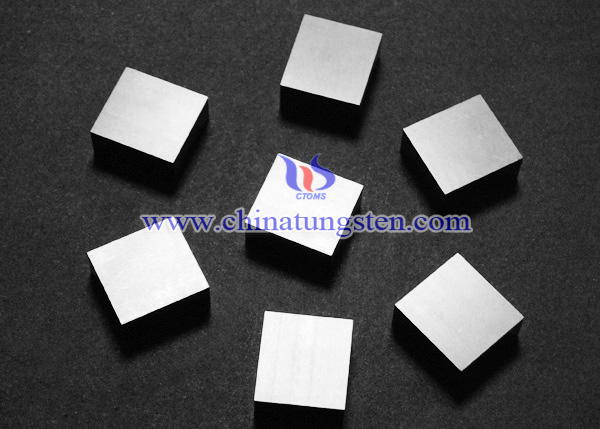 Dual-energy X-ray absorptiometry is a medical instrumentation of measuring bone mineral density and obtaining relevant data. Two X-ray beams, with different energy levels, are intended to the patient's bones. When soft tissue absorption is subtracted out, the bone mineral density can be determined from the absorption of each beam by bone. Dual-energy X-ray absorptiometry is the most widely used and most thoroughly studied bone density measurement technology. The test results of dual-energy X-ray absorptiometry is more accurate, and is the gold standard for bone density which WHO adopted. Dual-energy X-ray absorptiometry can be used to determine the absorption and ingestion conditions of the raw materials of bones during the process of growth and development of children, and analyze internal and external factors that may affect the growth of children, for the timely development of targeted nutrition programs and exercise plans, to ensure that the advantages of children in the aspects of bone growth and development.
Dual-energy X-ray absorptiometry is a medical instrumentation of measuring bone mineral density and obtaining relevant data. Two X-ray beams, with different energy levels, are intended to the patient's bones. When soft tissue absorption is subtracted out, the bone mineral density can be determined from the absorption of each beam by bone. Dual-energy X-ray absorptiometry is the most widely used and most thoroughly studied bone density measurement technology. The test results of dual-energy X-ray absorptiometry is more accurate, and is the gold standard for bone density which WHO adopted. Dual-energy X-ray absorptiometry can be used to determine the absorption and ingestion conditions of the raw materials of bones during the process of growth and development of children, and analyze internal and external factors that may affect the growth of children, for the timely development of targeted nutrition programs and exercise plans, to ensure that the advantages of children in the aspects of bone growth and development.
The X-ray generated by dual-energy X-ray absorptiometry is an electromagnetic wave with short wavelength (shorter than the wavelength of visible light), large energy (tens to hundreds of thousands of times larger than the photon energy of visible light) and has penetrating effect, ionization effect and thermal effect. When the human body is irradiated with X ray, X ray can inhibit, destroy and even kill human cells, lead to varying degrees of changes in the physiology, pathology and biochemical aspects of human body. X-rays can also cause hair loss, skin burns, sight disorders, leukemia and other issues. In addition, X-rays also have an impact on the fetus by causing physical handicaps, fetal malformations, fetal brain dysplasia, as well as increasing the probability of childhood cancer. The tungsten alloy shielding can be used to shield X-ray radiation generated by dual-energy X-ray absorptiometry.
Tungsten alloy shielding for dual-energy X-ray absorptiometry is made of tungsten heavy alloy. Tungsten heavy alloy is a tungsten-based material that adds a small amount of nickel, copper, iron, cobalt, molybdenum, chromium and other metal binders. It has the characteristics of high density, high strength, good absorption capacity of rays and good machining property. Because the greater density of the metal means the better absorption capacity and shielding capability of rays, thus tungsten alloy shielding for dual energy X-ray absorptiometry has excellent radiation shielding property that can effectively shield the X-ray generated by dual-energy X-ray absorptiometry.
| Tungsten Alloy Supplier: Chinatungsten Online www.tungsten-alloy.com | Tel.: 86 592 5129696; Fax: 86 592 5129797;Email:sales@chinatungsten.com |
| Tungsten News & Prices, 3G Version: http://3g.chinatungsten.com | Molybdenum News & Molybdenum Price: http://news.molybdenum.com.cn |



 sales@chinatungsten.com
sales@chinatungsten.com